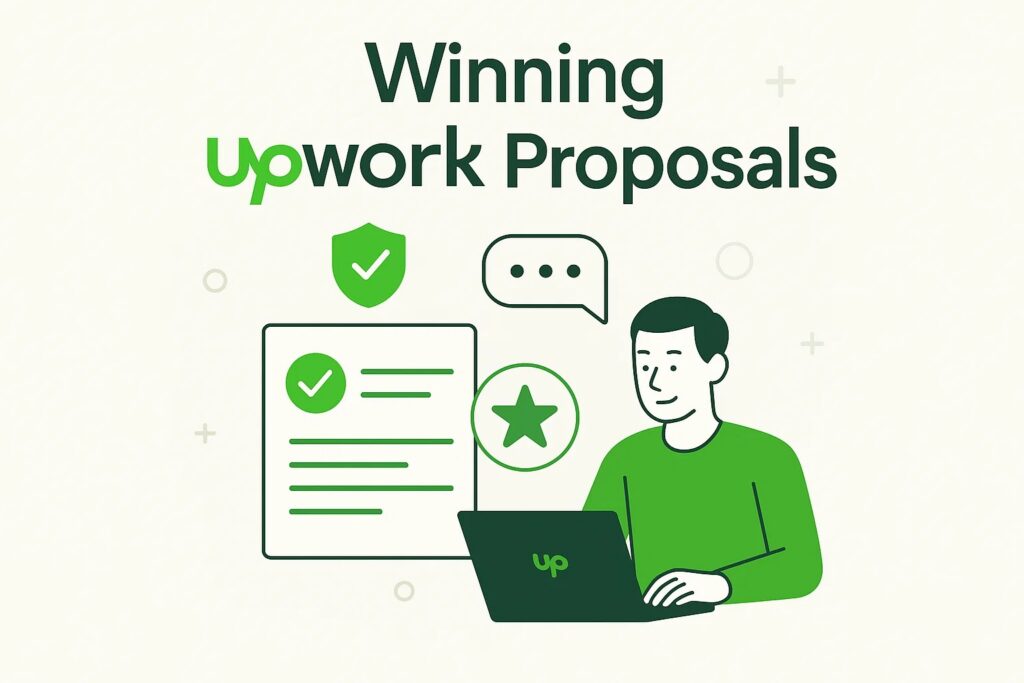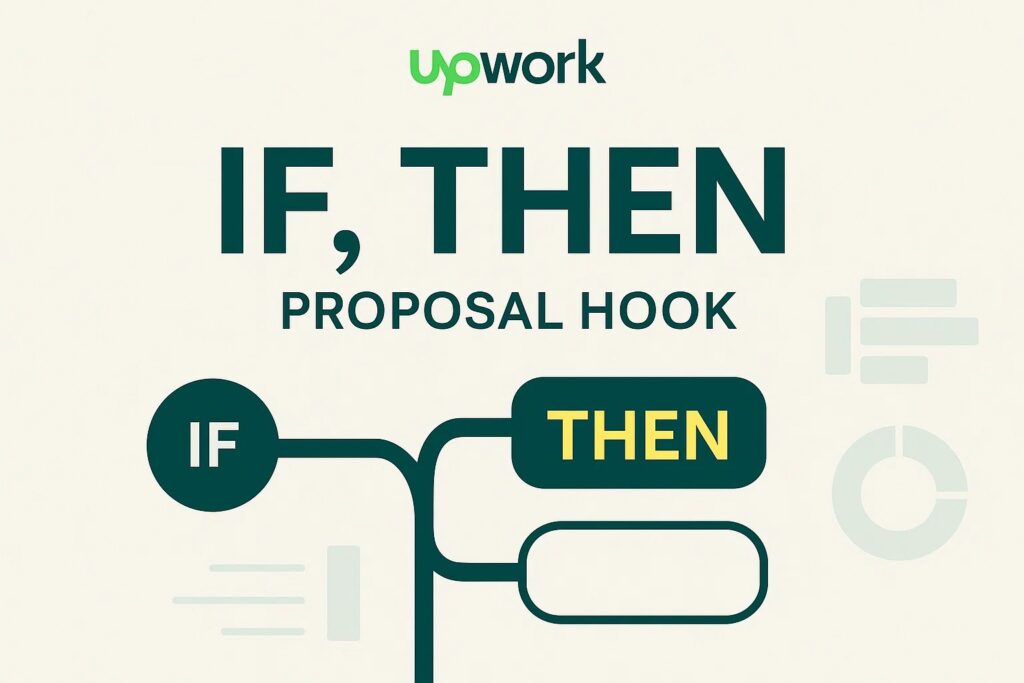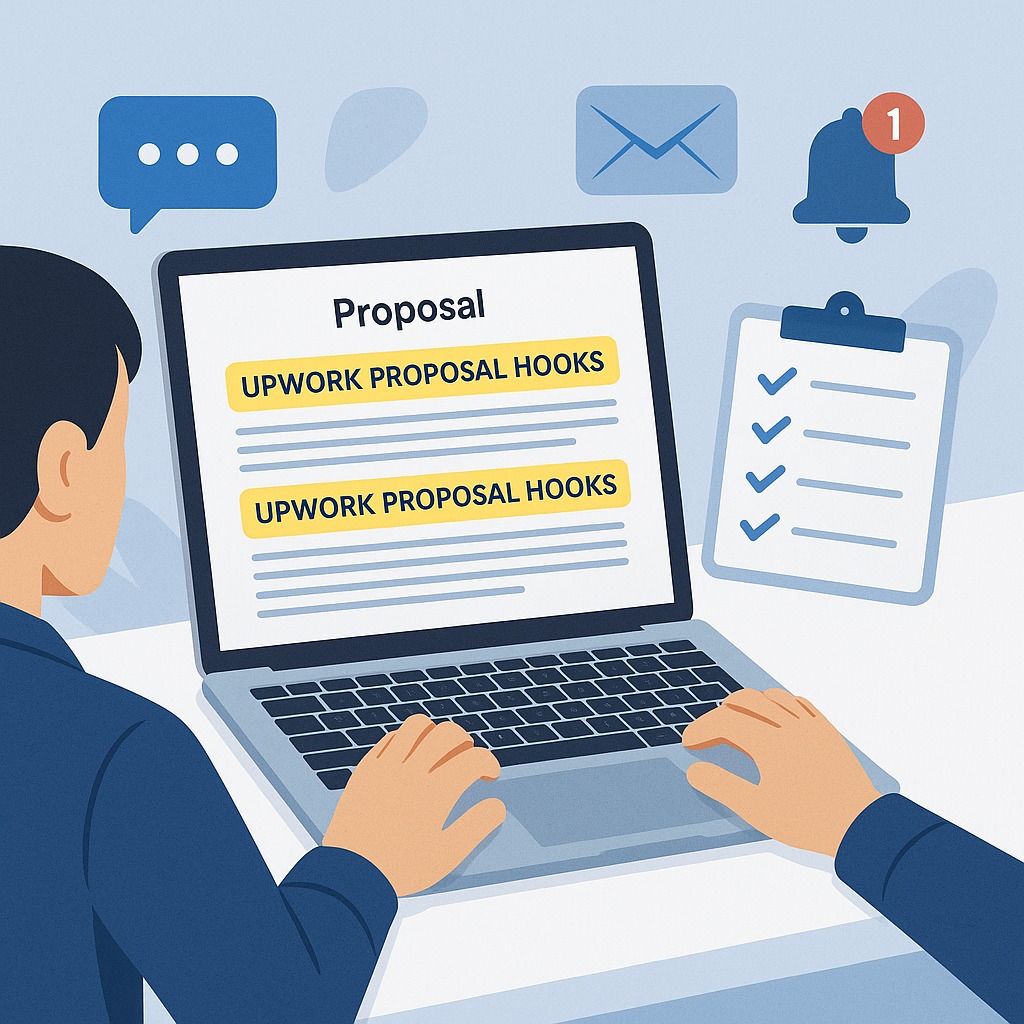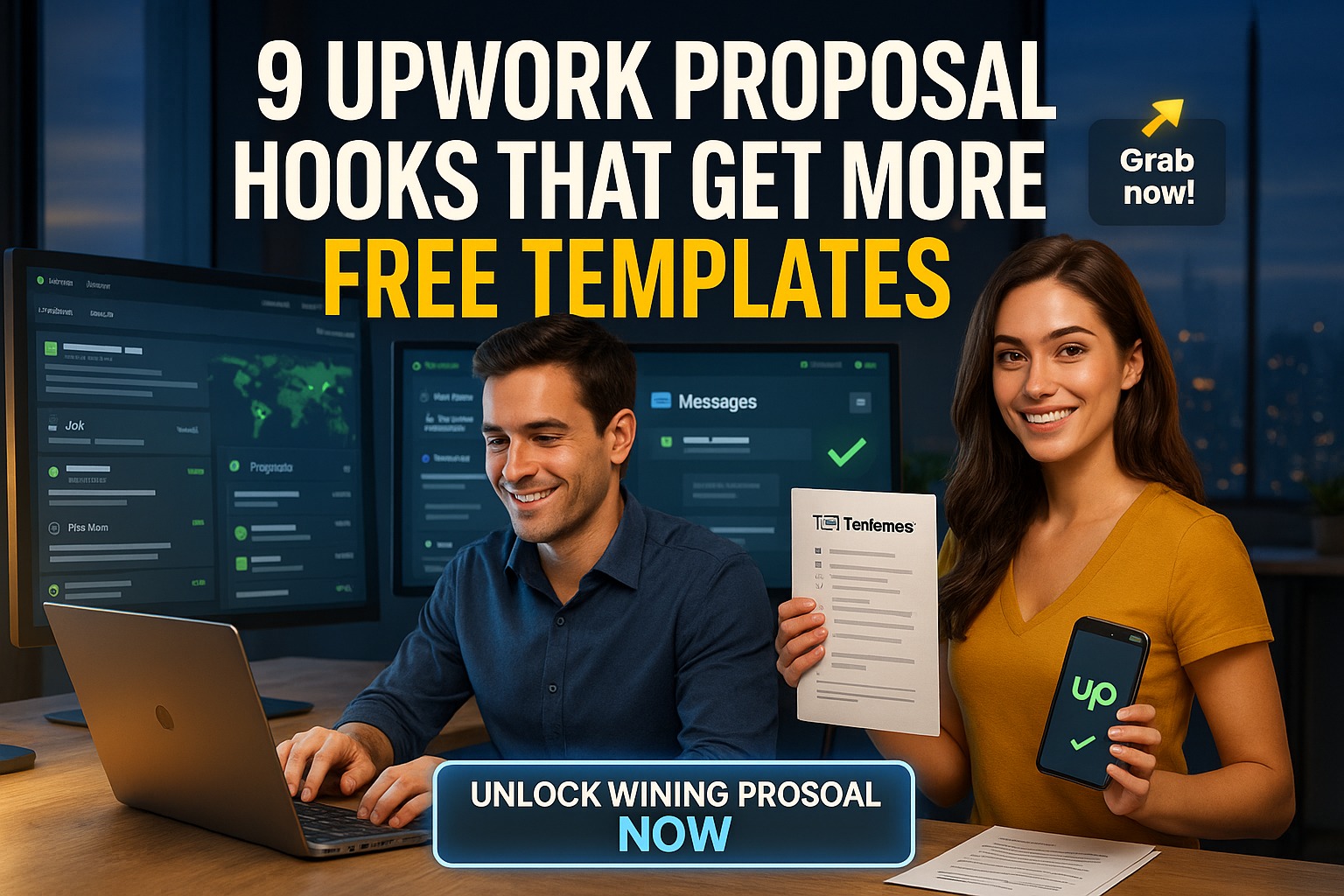Table of Contents
Introduction
Winning clients on Upwork is more competitive than ever. With thousands of freelancers vying for attention, your Upwork proposal must instantly grab a client’s interest and build trust. According to industry experts, the first few lines of your proposal determine whether a client reads on or moves to the next candidate. This is where proposal “hooks” come in—powerful opening lines or strategies that make your proposal irresistible.
In this comprehensive guide, you’ll learn nine proven hooks that top freelancers use to land more clients on Upwork Using Below Upwork Proposal Hooks. Each hook is backed by real-world examples and actionable templates, directly sourced and expanded from expert insights. Whether you’re a beginner or a seasoned freelancer, these techniques will help you stand out, increase your response rate, and win more contracts. Get ready to transform your Upwork proposals with strategies that work in 2025 and beyond.

Background & Context
Freelance platforms like Upwork have revolutionized the way professionals connect with clients worldwide. However, this accessibility has led to increased competition, making it vital for freelancers to differentiate themselves. The PDF source emphasizes that sharing personal or client results, telling compelling stories, and using data-driven statements are key to capturing a client’s attention.
Historically, generic proposals dominated the platform, but as clients became more discerning, the need for tailored, value-driven communication grew. Today, Upwork proposals must not only showcase skills but also convey credibility, results, and personality—often within the first few lines.
Industry trends show that clients respond best to proposals that quickly demonstrate understanding of their needs and offer proof of past success. The hooks outlined in the source material are designed to address these trends, providing freelancers with practical tools to increase their chances of landing high-quality projects.
1 Personal Results: Building Instant Trust
One of the strongest hooks is sharing your personal results. As highlighted in the PDF, this approach does three things: it grabs attention, shifts focus onto you, and builds trust. When you open your proposal with a specific achievement—such as “The PPC strategy I used to make $11k last month for my Amazon client”—clients immediately see your expertise in action.
Why it works:
Clients want proof that you can deliver. Personal results serve as social proof and demonstrate that you have real-world experience solving similar problems.
How to use it:
Start your proposal with a concise statement of your achievement, followed by a brief explanation of how you did it. For example:
“Last month, I helped an Amazon seller generate $11,000 in sales using a targeted PPC strategy. Here’s how I can apply the same approach to your project…”
Template:
“I recently [achieved X result] for [client/project], and I’d love to bring the same results to your business.”
Example:
“I increased a Shopify store’s conversion rate by 37% in just 30 days. Let’s discuss how I can help you achieve similar growth.”
2 Client Results: Leveraging Social Proof
If you’re new or prefer highlighting your clients’ successes, this hook is for you. The PDF suggests sharing a client’s results as a way to build credibility and demonstrate your impact.
Why it works:
Clients are reassured when they see you’ve helped others succeed, especially in similar industries or project types.
How to use it:
Open with a result you achieved for a client, then relate it to the prospect’s needs.
Template:
“My client achieved [notable result] after I [describe your contribution]. Here’s how I can do the same for you.”
Example:
“My client’s website achieved a 37.1% CTR within 19 days of launch, thanks to my landing page optimization strategy.”
3. Start a Story: Engaging Through Narrative
People love stories. The PDF outlines three ways to use storytelling in your proposal: start from the beginning, the middle, or summarize the story in a few sentences.
Why it works:
Stories are memorable and emotionally engaging. They help clients visualize your process and results.
How to use it:
Begin your proposal with a story relevant to the client’s project. For example:
“When I first started working with [client], their e-commerce site was struggling to convert visitors. Within a month, we turned things around…”
Template:
“Let me share a quick story about how I solved a similar challenge…”
Example:
“I built a strategy that ranked a client’s website in 35 days—here’s how I can help you achieve the same.”
4. If, Then Formula: Targeted Relevance
This hook uses an “if, then” statement to call out your ideal client and lead them into your proposal.
Why it works:
It instantly filters for clients who resonate with your approach and draws them in.
How to use it:
Start with an “if” statement addressing the client’s main concern, followed by a “then” statement offering your solution.
Template:
“If you [describe client’s need], then I’m the right freelancer for you.”
Example:
“If you value quality over price, I can deliver results that exceed your expectations.”
5. Stats & Data: Establishing Authority
Using statistics or data points, as recommended in the PDF, positions you as an expert and grabs attention.
Why it works:
Clients are impressed by data-driven approaches and want to work with professionals who understand the numbers.
How to use it:
Open with a relevant statistic, then explain how your skills or strategies address the issue.
Template:
“[Statistic]. Here’s how I help clients leverage this insight for better results.”
Example:
“10,000 Shopify stores are launched each week, but 99% fail due to poor landing pages. My framework ensures your store stands out.”
6. Get X Without Y: Irresistible Offers
This classic copywriting formula promises a desirable outcome without an unwanted action.
Why it works:
It makes your offer more appealing by removing barriers or pain points.
How to use it:
Clearly state the benefit (X) and what the client won’t have to do (Y).
Template:
“How to [achieve X] without [doing Y].”
Example:
“How to make $10k per month—even if you’re average in English.”
7. “I Did the Hard Part” Hook: Demonstrating Value
Clients want results quickly and easily. This hook shows you’ve already done the heavy lifting.
Why it works:
It positions you as an expert who can shortcut the client’s path to success.
How to use it:
Mention the effort or investment you’ve made, and how the client benefits.
Template:
“I spent [time/money/effort] so you don’t have to.”
Example:
“I sent 1 million emails last year—here are the 13 mistakes you must avoid to boost sales.”
8. “Give Me X, I’ll Deliver Y” Hook: Quick Wins
This hook promises a valuable result in a short timeframe, making your proposal hard to resist.
Why it works:
It creates urgency and makes the client feel they’re getting a great deal.
How to use it:
Offer a specific result in a defined period.
Template:
“Give me [time], and I’ll [deliver result].”
Example:
“Give me 14 days, and I’ll rank your website on Google’s first page.”
9. Free Sample or Trial: Risk-Free Value
Offering a free sample or trial, as the PDF suggests, is like a “cheat code” for winning clients.
Why it works:
It lowers the client’s risk and gives them a taste of your quality.
How to use it:
Offer to complete a small task for free, or provide a sample of your work.
Template:
“I’ll [do X for free] so you can see the results before committing.”
Example:
“I’ll write the first 3 emails for free—work with me only if you love the results.”

Analysis & Insights
The nine hooks outlined above are not just theoretical—they’re battle-tested strategies used by top freelancers to consistently win clients on Upwork. The PDF emphasizes that these hooks can be combined for even greater impact. For example, starting with a personal result and following up with a free sample offer can dramatically increase your response rate.
Expert analysis of successful proposals shows that personalization and specificity are key. Generic, copy-paste proposals rarely succeed. Instead, proposals that quickly demonstrate understanding of the client’s pain points, backed by real results and clear offers, stand out.
The use of data and storytelling in proposals aligns with broader trends in digital marketing, where authenticity and measurable outcomes drive purchasing decisions. By integrating these hooks, freelancers can position themselves as trusted partners rather than just service providers.
Practical Applications
Implementing these hooks in your Upwork proposals is straightforward:
- Choose the Right Hook:
Analyze the client’s job post and select the hook that best fits their needs. - Customize Your Opening:
Adapt the template to your experience and the client’s project. - Combine Hooks:
Mix and match hooks for maximum effect—e.g., start with a statistic, then offer a free sample. - Use Templates Wisely:
Personalize each proposal. Avoid generic statements. - Track Results:
Monitor response rates and refine your approach based on what works.
Common Pitfalls:
- Overusing the same hook for every proposal
- Failing to personalize your message
- Making claims without proof or examples
Success Factors:
- Authenticity
- Specificity
- Relevance to the client’s needs

Benefits & Outcomes
Applying these nine hooks to your Upwork proposals can yield measurable benefits:
- Higher Response Rates: Stand out in crowded applicant pools.
- Increased Trust: Build credibility with proof and transparency.
- More Meetings & Contracts: Move clients from interest to action.
- Repeat Business: Satisfied clients are more likely to rehire.
- Competitive Edge: Differentiate yourself from generic proposals.
Future Considerations
As Upwork evolves, so do client expectations. Emerging trends include so (Upwork Proposal):
- AI-Assisted Proposal Screening: Personalization and data-driven hooks will become even more critical.
- Video Proposals: Storytelling and proof will extend to video formats.
- Niche Specialization: Tailoring hooks to specific industries or project types.
To stay ahead, continue refining your hooks, monitor industry trends, and experiment with new formats.
Conclusion
Mastering the art of the Upwork proposal is essential for freelancers seeking long-term success. By using these nine hooks—personal results, client results, storytelling, the If-Then formula, data, irresistible offers, value demonstration, quick wins, and free samples—you can dramatically improve your chances of getting noticed and hired. Start applying these strategies today to make your Upwork proposals more persuasive, trustworthy, and effective.
Frequently Asked Questions
What are the most effective hooks for an Upwork proposal?
The most effective hooks include sharing personal or client results, starting with a compelling story, using data-driven statements, and offering free samples. These approaches quickly build trust and capture client attention.
How can I personalize my Upwork proposal hooks?
Personalize by referencing specific client needs, using relevant examples from your experience, and adapting templates to each job post. Avoid generic statements and always tailor your opening to the client’s project.
Should I always offer a free sample in my proposal?
While offering a free sample can boost response rates, use it strategically. Only offer samples when you’re confident it will lead to a contract, and ensure it doesn’t devalue your work.
Can I combine multiple hooks in one Upwork proposal?
Yes, combining hooks—such as starting with a personal result and following with a free offer—can make your proposal even more compelling and increase your chances of success.
How do I measure the success of my Upwork proposal hooks?
Track response rates, interview invitations, and contract wins. Refine your approach based on which hooks generate the most positive client feedback and conversions.
Link Building Strategy
Internal Links:
- Learn more about effective freelancing strategies
- Explore our guide on client communication
- Discover additional insights on proposal writing
External Links:
- Upwork’s official proposal guidelines
- Research on client acquisition for freelancers
- Industry insights from HubSpot on proposal writing
Sharing your results is the fastest way to build trust and win more Upwork clients. #Freelancing #UpworkProposal





